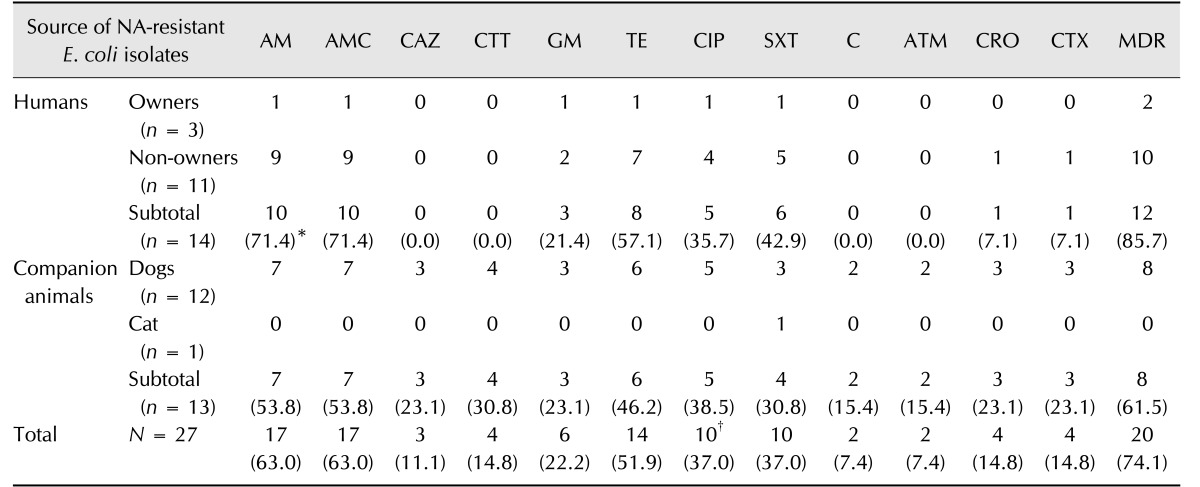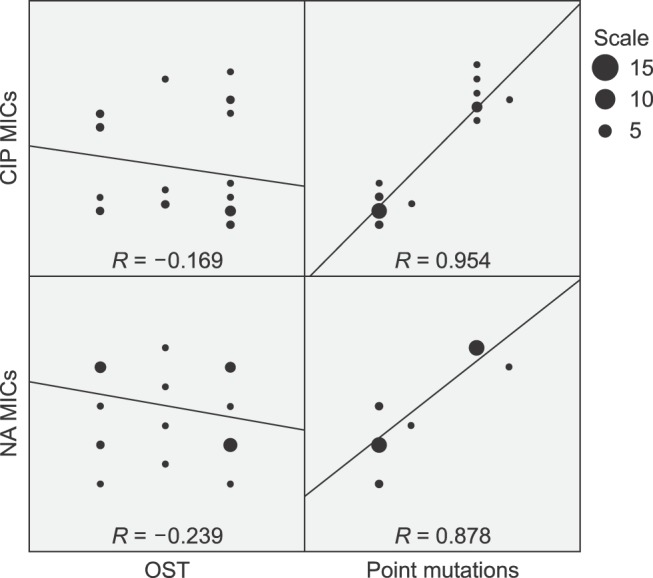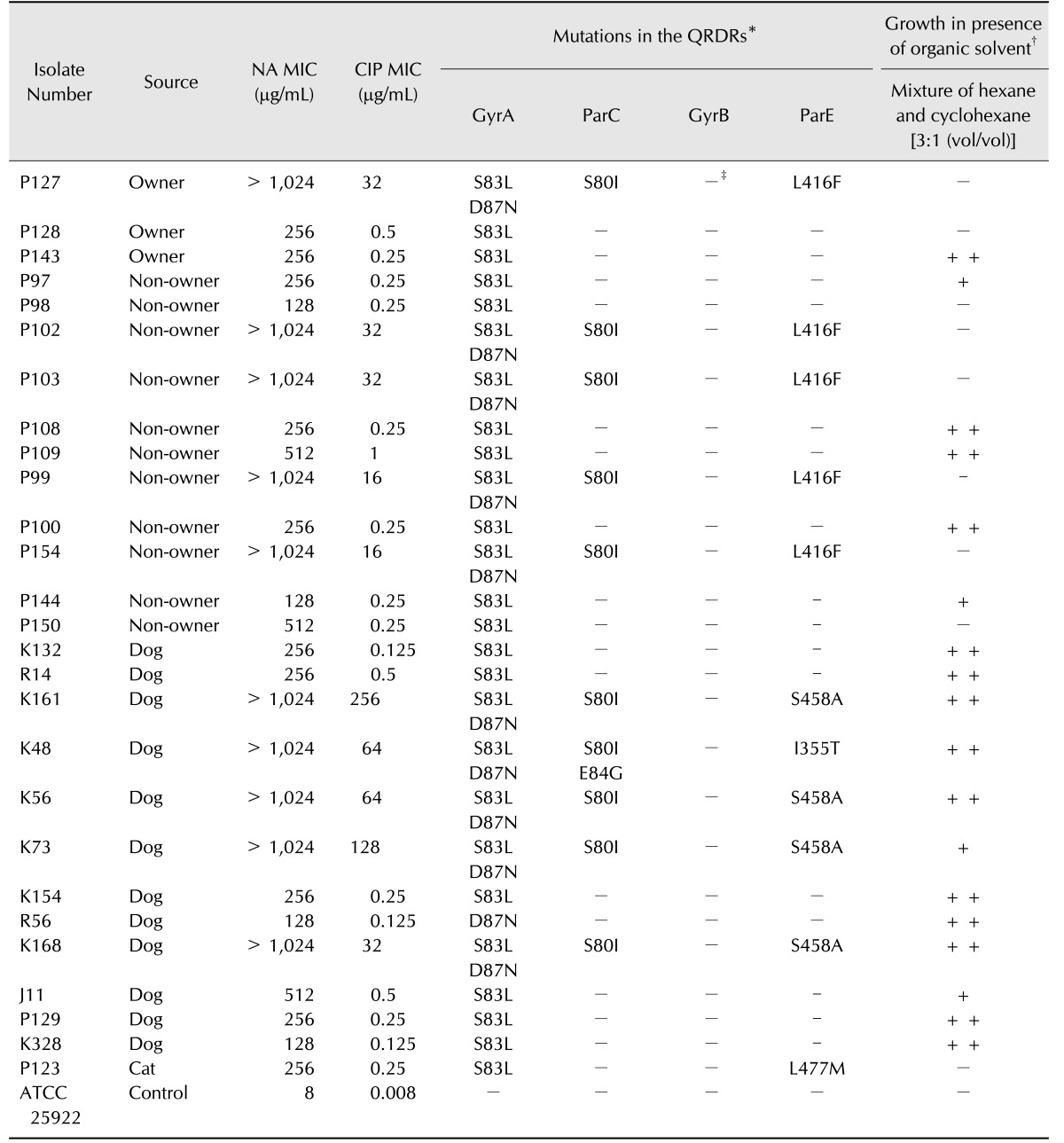1. Aathithan S, French GL. Organic solvent tolerance and fluoroquinolone resistance in
Klebsiella pneumoniae clinical isolates. J Antimicrob Chemother. 2009; 64:870–871. PMID:
19679596.
2. Bai H, Du Jf, Hu M, Qi J, Cai YN, Niu WW, Liu YQ. Analysis of mechanisms of resistance and tolerance of Escherichia coli to enrofloxacin. Ann Microbiol. 2012; 62:293–298.
3. Bennett PM. Plasmid encoded antibiotic resistance: acquisition and transfer of antibiotic resistance genes in bacteria. Br J Pharmacol. 2008; 153(Suppl 1):S347–S357. PMID:
18193080.

4. Breines DM, Ouabdesselam S, NG EY, Tankovic J, Shah S, Soussy CJ, Hooper DC. Quinolone resistance locus nfxD of
Escherichia coli is a mutant allele of the parE gene encoding a subunit of topoisomerase IV. Antimicrob Agents Chemother. 1997; 41:175–179. PMID:
8980775.
5. Cattoir V, Poirel L, Rotimi V, Soussy CJ, Nordmann P. Multiplex PCR for detection of plasmid-mediated quinolone resistance qnr genes in ESBL-producing enterobacterial isolates. J Antimicrob Chemother. 2007; 60:394–397. PMID:
17561500.

6. Chung YS, Song JW, Kim DH, Shin S, Park YK, Yang SJ, Lim SK, Park KT, Park YH. Isolation and characterization of antimicrobial-resistant
E. coli from national horse racetracks and private horse-riding courses in Korea. J Vet Sci. 2016; 17:199–206. PMID:
26645344.
7. CLSI. Performance Standards for Antimicrobial Susceptibility Testing; Nineteenth Informational Supplement. CLSI document M100-S19. Wayne: Clinical and Laboratory Standards Institute;2009.
8. Corcoran D, Quinn T, Cotter L, Fanning S. Relative contribution of target gene mutation and efflux to varying quinolone resistance in Irish
Campylobacter isolates. FEMS Microbiol Lett. 2005; 253:39–46. PMID:
16213669.
9. Doyle MP, Ruoff KL, Pierson M, Weinberg W, Soule B, Michaels BS. Reducing transmission of infectious agents in the home-part I: sources of infection. Dairy Food Environ Sanit. 2000; 20:330–337.
10. Fendukly F, Karlsson I, Hanson HS, Kronvall G, Dornbusch K. Patterns of mutations in target genes in septicemia isolates of
Escherichia coli and
Klebsiella pneumoniae with resistance or reduced susceptibility to ciprofloxacin. APMIS. 2003; 111:857–866. PMID:
14510643.
11. Frank T, Mbecko JR, Misatou P, Monchy D. Emergence of quinolone resistance among extended-spectrum beta-lactamase-producing
Enterobacteriaceae in the Central African Republic: genetic characterization. BMC Res Notes. 2011; 4:309. PMID:
21867486.

12. Gandolfi-Decristophoris P, De Benedetti A, Petignat C, Attinger M, Guillaume J, Fiebig L, Hattendorf J, Cernela N, Regula G, Petrini O, Zinsstag J, Schelling E. Evaluation of pet contact as a risk factor for carriage of multidrug-resistant staphylococci in nursing home residents. Am J Infect Control. 2012; 40:128–133. PMID:
21824684.
13. Guillard T, de Jong A, Limelette A, Lebreil AL, Madoux J, de Champs C. The ComPath Study Group. Characterization of quinolone resistance mechanisms in
Enterobacteriaceae recovered from diseased companion animals in Europe. Vet Microbiol. 2016; 194:23–29. PMID:
26701806.
14. Gustavsson L, Westin J, Andersson LM, Lindh M. Rectal swabs can be used for diagnosis of viral gastroenteritis with a multiple real-time PCR assay. J Clin Virol. 2011; 51:279–282. PMID:
21683649.

15. Heisig P, Tschorny R. Characterization of fluoroquinolone-resistant mutants of
Escherichia coli selected in vitro. Antimicrob Agents Chemother. 1994; 38:1284–1291. PMID:
8092826.
16. Hopkins KL, Davies RH, Threlfall EJ. Mechanisms of quinolone resistance in
Escherichia coli and
Salmonella: recent developments. Int J Antimicrob Agents. 2005; 25:358–373. PMID:
15848289.
17. Jacoby GA. Mechanisms of resistance to quinolones. Clin Infect Dis. 2005; 41(Suppl 2):S120–S126. PMID:
15942878.

18. Jiang Y, Zhou Z, Qian Y, Wei Z, Yu Y, Hu S, Li L. Plasmid-mediated quinolone resistance determinants
qnr and
aac(
6′)-
Ib-
cr in extended-spectrum β-lactamase-producing
Escherichia coli and
Klebsiella pneumoniae in China. J Antimicrob Chemother. 2008; 61:1003–1006. PMID:
18299311.
19. Karczmarczyk M, Martins M, Quinn T, Leonard N, Fanning S. Mechanisms of fluoroquinolone resistance in
Escherichia coli isolates from food-producing animals. Appl Environ Microbiol. 2011; 77:7113–7120. PMID:
21856834.
20. Khodursky AB, Zechiedrich EL, Cozzarelli NR. Topoisomerase IV is a target of quinolones in
Escherichia coli. Proc Natl Acad Sci U S A. 1995; 92:11801–11805. PMID:
8524852.
21. Kos VN, Desjardins CA, Griggs A, Cerqueira G, Van Tonder A, Holden MT, Godfrey P, Palmer KL, Bodi K, Mongodin EF. Comparative genomics of vancomycin-resistant
Staphylococcus aureus strains and their positions within the clade most commonly associated with methicillin-resistant
S. aureus hospital-acquired infection in the United States. MBio. 2012; 3:e00112-12. PMID:
22617140.

22. Liebana E, Batchelor M, Hopkins K, Clifton-Hadley F, Teale C, Foster A, Barker L, Threlfall E, Davies R. Longitudinal farm study of extended-spectrum β-lactamase-mediated resistance. J Clin Microbiol. 2006; 44:1630–1634. PMID:
16672386.

23. Ma J, Zeng Z, Chen Z, Xu X, Wang X, Deng Y, Lü D, Huang L, Zhang Y, Liu J. High prevalence of plasmid-mediated quinolone resistance determinants
qnr,
aac(
6′)-
Ib-
cr, and
qepA among ceftiofur-resistant
Enterobacteriaceae isolates from companion and food-producing animals. Antimicrob Agents Chemother. 2009; 53:519–524. PMID:
18936192.
24. Morgan-Linnell SK, Boyd LB, Steffen D, Zechiedrich L. Mechanisms accounting for fluoroquinolone resistance in
Escherichia coli clinical isolates. Antimicrob Agents Chemother. 2009; 53:235–241. PMID:
18838592.
25. Nam YS, Cho SY, Yang HY, Park KS, Jang JH, Kim YT, Jeong JW, Suh JT, Lee HJ. Investigation of mutation distribution in DNA gyrase and topoisomerase IV genes in ciprofloxacin-non-susceptible
Enterobacteriaceae isolated from blood cultures in a tertiary care university hospital in South Korea, 2005–2010. Int J Antimicrob Agents. 2013; 41:126–129. PMID:
23265914.
26. Park CH, Robicsek A, Jacoby GA, Sahm D, Hooper DC. Prevalence in the United States of
aac(
6′)-
Ib-
cr encoding a ciprofloxacin-modifying enzyme. Antimicrob Agents Chemother. 2006; 50:3953–3955. PMID:
16954321.
27. Redgrave LS, Sutton SB, Webber MA, Piddock LJ. Fluoroquinolone resistance: mechanisms, impact on bacteria, and role in evolutionary success. Trends Microbiol. 2014; 22:438–445. PMID:
24842194.

28. Sato T, Yokota Si, Okubo T, Ishihara K, Ueno H, Muramatsu Y, Fujii N, Tamura Y. Contribution of the AcrAB-TolC efflux pump to high-level fluoroquinolone resistance in
Escherichia coli isolated from dogs and humans. J Vet Med Sci. 2013; 75:407–414. PMID:
23149545.
29. Schneiders T, Amyes S, Levy S. Role of AcrR and RamA in fluoroquinolone resistance in clinical
Klebsiella pneumoniae isolates from Singapore. Antimicrob Agents Chemother. 2003; 47:2831–2837. PMID:
12936981.
30. So JH, Kim J, Bae IK, Jeong SH, Kim SH, Lim SK, Park YH, Lee K. Dissemination of multidrug-resistant
Escherichia coli in Korean veterinary hospitals. Diagn Microbiol Infect Dis. 2012; 73:195–199. PMID:
22516765.
31. Strand L, Jenkins A, Henriksen IH, Allum AG, Grude N, Kristiansen BE. High levels of multiresistance in quinolone resistant urinary tract isolates of
Escherichia coli from Norway; a non clonal phenomen? BMC Res Notes. 2014; 7:376. PMID:
24941949.

32. Vila J, Ruiz J, Goñi P, De Anta M. Detection of mutations in parC in quinolone-resistant clinical isolates of
Escherichia coli. Antimicrob Agents Chemother. 1996; 40:491–493. PMID:
8834907.
33. von Salviati C, Laube H, Guerra B, Roesler U, Friese A. Emission of ESBL/AmpC-producing
Escherichia coli from pig fattening farms to surrounding areas. Vet Microbiol. 2015; 175:77–84. PMID:
25465658.
34. Wang H, Dzink-Fox JL, Chen M, Levy SB. Genetic characterization of highly fluoroquinolone-resistant clinical
Escherichia coli strains from China: role of acrR mutations. Antimicrob Agents Chemother. 2001; 45:1515–1521. PMID:
11302820.
35. White DG, Goldman JD, Demple B, Levy SB. Role of the
acrAB locus in organic solvent tolerance mediated by expression of
marA,
soxS, or
robA in
Escherichia coli. J Bacteriol. 1997; 179:6122–6126. PMID:
9324261.
36. Yamane K, Wachino Ji, Suzuki S, Arakawa Y. Plasmid-mediated
qepA gene among
Escherichia coli clinical isolates from Japan. Antimicrob Agents Chemother. 2008; 52:1564–1566. PMID:
18285488.
37. Yang H, Duan G, Zhu J, Zhang W, Xi Y, Fan Q. Prevalence and characterisation of plasmid-mediated quinolone resistance and mutations in the gyrase and topoisomerase IV genes among
Shigella isolates from Henan, China, between 2001 and 2008. Int J Antimicrob Agents. 2013; 42:173–177. PMID:
23796894.
38. Yoshida H, Bogaki M, Nakamura M, Nakamura S. Quinolone resistance-determining region in the DNA gyrase gyrA gene of
Escherichia coli. Antimicrob Agents Chemother. 1990; 34:1271–1272. PMID:
2168148.
39. Yue L, Jiang HX, Liao XP, Liu JH, Li SJ, Chen XY, Chen CX, Lü DH, Liu YH. Prevalence of plasmid-mediated quinolone resistance
qnr genes in poultry and swine clinical isolates of
Escherichia coli. Vet Microbiol. 2008; 132:414–420. PMID:
18573620.
40. Zurfluh K, Abgottspon H, Hächler H, Nüesch-Inderbinen M, Stephan R. Quinolone resistance mechanisms among extended-spectrum beta-lactamase (ESBL) producing
Escherichia coli isolated from rivers and lakes in Switzerland. PLoS One. 2014; 9:e95864. PMID:
24755830.






 PDF
PDF Citation
Citation Print
Print




 XML Download
XML Download